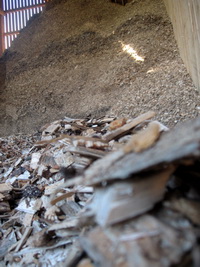 On a sunny Saturday afternoon in Salzburg, we took a field trip to a few examples of biomass in rural Austria. The country is over 40 percent forested, and over half of the forest is owned by small farmers with less than 40 hectares (just under 100 acres), so the government has put a priority on encouraging biomass use as a substitute for fossil fuels. It’s a stable domestic industry, carefully managed with an eye toward local economic development and, as with just about everything I laid eyes on in Austria, proper aesthetics.
On a sunny Saturday afternoon in Salzburg, we took a field trip to a few examples of biomass in rural Austria. The country is over 40 percent forested, and over half of the forest is owned by small farmers with less than 40 hectares (just under 100 acres), so the government has put a priority on encouraging biomass use as a substitute for fossil fuels. It’s a stable domestic industry, carefully managed with an eye toward local economic development and, as with just about everything I laid eyes on in Austria, proper aesthetics.
The first place we stopped was a biomass district heating co-op run by 18 farmers. To the right is the enormous pile of wood chips we saw in a huge, beautifully wrought barn.
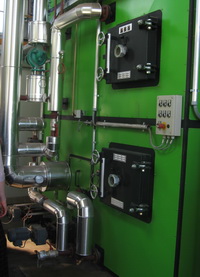 The chips are continuously and automatically fed into the hyper-efficient furnace to the left, where they are burned at high temperatures. The combustion heats water, which is then fed through a network of pipes underneath the village. A system of heat exchangers uses the water to heat each house.
The chips are continuously and automatically fed into the hyper-efficient furnace to the left, where they are burned at high temperatures. The combustion heats water, which is then fed through a network of pipes underneath the village. A system of heat exchangers uses the water to heat each house.
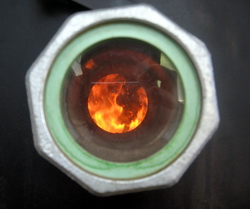 (That’s a porthole to the furnace flames on the right.)
(That’s a porthole to the furnace flames on the right.)
Obviously the farmers make more money during the cold winters, but the co-op provides a stable, predictable supplemental income throughout the year.
The next place we visited was a biomass digester::
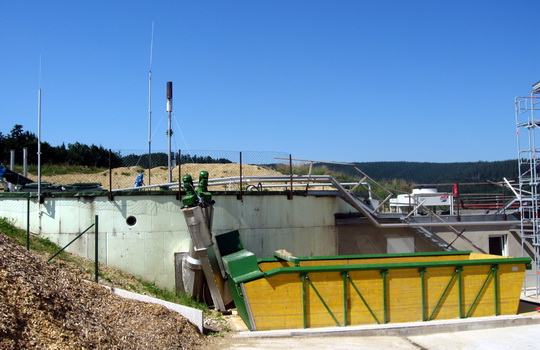
 Instead of burning pure wood, it feeds a mixture of wood, straw, and godknowswhat from that yellow bin in front (it was stinky!) into the huge tank to the left, where it ferments. The gases released by the fermentation are captured, fed into the building to the far right (not quite visible), and burned to create electricity, which is fed into the grid. The leftover sludgy stuff is distributed as mulch. The hot air created by the generator is piped into a building next door and used to dry wood chips, which are then shredded and used to make compact wood pellets.
Instead of burning pure wood, it feeds a mixture of wood, straw, and godknowswhat from that yellow bin in front (it was stinky!) into the huge tank to the left, where it ferments. The gases released by the fermentation are captured, fed into the building to the far right (not quite visible), and burned to create electricity, which is fed into the grid. The leftover sludgy stuff is distributed as mulch. The hot air created by the generator is piped into a building next door and used to dry wood chips, which are then shredded and used to make compact wood pellets.
Delightful! Both these facilities were so … I don’t want to say low-tech. Analog. They were like fantastic Rube Goldberg machines, squeezing every bit of useful energy out of local, renewable material. This stuff is heavily subsidized by the government, but it has helped (along with tourism) revive several local economies.
Let’s keep going! Stop No. 3: a brand new town hall, just built for a small Austrian village, the name of which I do not quite recall:
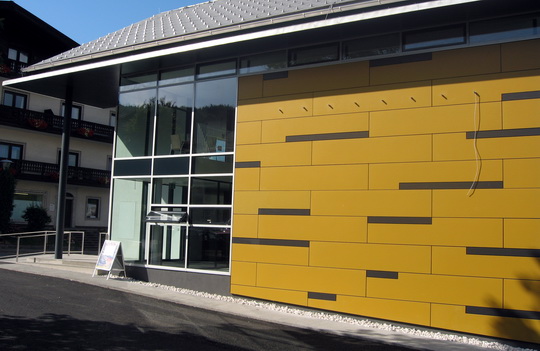
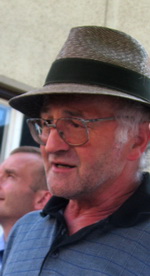
 The guy on the far left is the mayor, who entered his town into a contest and won the services of the guy next to him — the architect who designed the building. Note that the roof pitch and overall shape echo the traditional architecture of the town. Its walls, however, are a total of 45cm thick, with layers of insulation, air, wood, metal, and concrete. That kind of thermal mass makes heating and cooling easy.
The guy on the far left is the mayor, who entered his town into a contest and won the services of the guy next to him — the architect who designed the building. Note that the roof pitch and overall shape echo the traditional architecture of the town. Its walls, however, are a total of 45cm thick, with layers of insulation, air, wood, metal, and concrete. That kind of thermal mass makes heating and cooling easy.
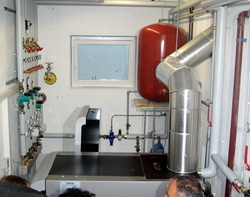 In the basement of the (gorgeous, spacious, well-lit) building is a small biomass furnace. Wood chips are blown from the delivery truck into one room and fed continuously from there into the furnace to the right, where they are burned, and the heat distributed throughout the building.
In the basement of the (gorgeous, spacious, well-lit) building is a small biomass furnace. Wood chips are blown from the delivery truck into one room and fed continuously from there into the furnace to the right, where they are burned, and the heat distributed throughout the building.
One of us asked if the biomass furnace was more expensive than the alternatives. Our tour guide — Christiane Egger, deputy manager of the Upper Austrian Renewable Energy Agency (Oberösterreichischer Energiesparverband) — snorted. “No one would ever think of heating a building like this with a non-renewable system today!” Perhaps her American friends haven’t told her that cost is the alpha and omega!
(Nice side note: The old town hall is going to be torn down and converted into an open town square.)
 Finally, last but not least, we come to a residential system. A kind Austrian couple allowed us to tramp around their house for a few minutes. To the right is the hole in the wall through which wood pellets are fed (excess sawdust — there are regulations — is sucked out of the hole on the right).
Finally, last but not least, we come to a residential system. A kind Austrian couple allowed us to tramp around their house for a few minutes. To the right is the hole in the wall through which wood pellets are fed (excess sawdust — there are regulations — is sucked out of the hole on the right).
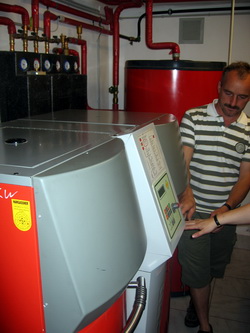 To the left is the furnace in the basement, along with the guy who installed the system, who looks eerily like Inspector Clouseau. The furnace heats water both for radiant heat and showers, etc. I was standing next to this appliance for a while, listening to him explain how pellets are fed in automatically based on a programmed thermometer, when he casually mentioned that it was on and running.
To the left is the furnace in the basement, along with the guy who installed the system, who looks eerily like Inspector Clouseau. The furnace heats water both for radiant heat and showers, etc. I was standing next to this appliance for a while, listening to him explain how pellets are fed in automatically based on a programmed thermometer, when he casually mentioned that it was on and running.
I was taken aback. There was no heat coming off it at all, no noise, not so much as a vibration. But he opened the gray door and sure enough, there was another porthole through which we could see dancing flames.
I came away from the day utterly charmed and impressed. Like so little in day-to-day American life, these systems are simple, resilient, and predictable, locally owned and run, and of appropriate scale and character. They fit.

